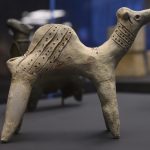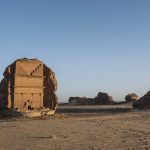
(Royal Commission of Al-Ula)
The researchers discovered the dog’s bones at a burial site that has been identified as one of the earliest monumental tombs in the Arabian Peninsula. Being the largest peninsula in the world, it comprises countries like Kuwait, Oman, Qatar, Saudi Arabia, the United Arab Emirates, Yemen, and southern parts of Iraq and Jordan.
The project team, along with international members, focused their efforts on two above-ground burial sites, located 130 kilometres apart, which dated back to the 5th and 4th millennia BCE. One of the sites was located in volcanic uplands, while the other was in arid badlands. The researchers found it unusual for the sites to be above ground in that period of Arabian history.
In the volcanic upland sites, 26 fragments of a single dog’s bones were unearthed along with bones from 11 human beings, including six adults, an adolescent, and four children. The uncovered bones of the dog showed signs of arthritis, which indicated that the animal lived with the human inhabitants till it grew old.
The team’s zoo archaeologist, Laura Strolin, was able to accurately identify the animal as a dog by analysing one particular bone from the animal’s left leg. The breadth of this bone was 21.0 mm, which is in the range of other ancient Middle Eastern dogs. This removed any doubts of the animal being a wolf, as wolves of that time and place had a breadth of 24.7 to 26 mm for the same bone.
Along with such archaeological evidence, the researchers also found rock art that depicted that the Neolithic inhabitants used dogs to hunt ibex and other prey. This strengthened their theory of the early domestication of dogs.
The fieldwork also uncovered other important artefacts like a leaf-shaped mother-of-pearl pendant at the volcanic uplands site and a carnelian bead at the arid badlands site. On account of these discoveries, the researchers assert that they expect to find more artefacts in the future, as these excavation sites are largely unexplored, even after being located in an area that is globally recognised for its fertile archaeological heritage.
“The Aerial Archaeology in the Kingdom of Saudi Arabia (AAKSAU) – AlUla project is at a point where we’re going to begin to realize how important it was to the development of mankind across the Middle East,” said the AAKSAU director, Hugh Thomas.
These discoveries came from one of the projects in the large-scale archaeological surveys and excavations of the region funded by the Royal Commission for AlUla (RCU). The findings of this research were published in the Journal of Field Archaeology and can be accessed here.
weather com














